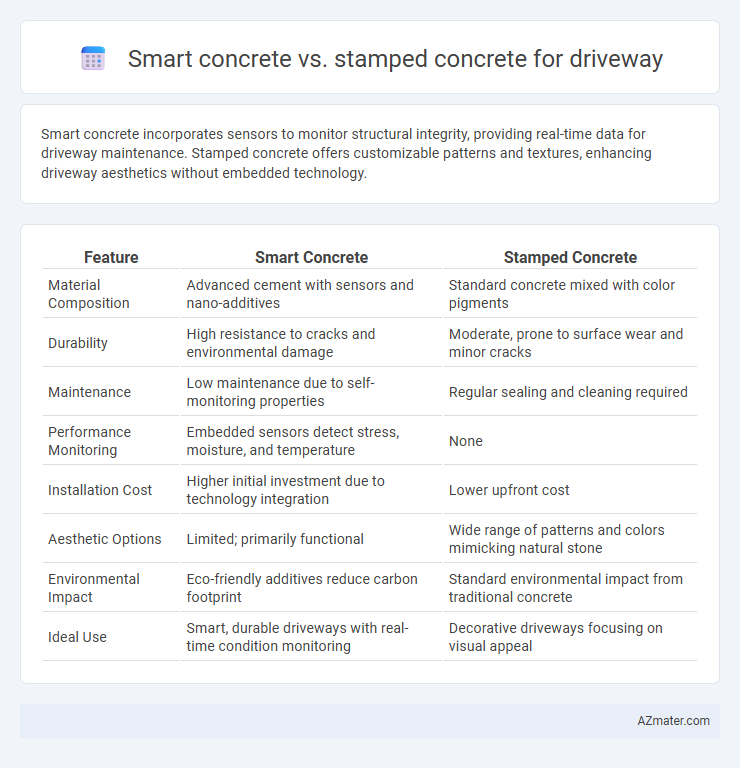Smart concrete incorporates sensors to monitor structural integrity, providing real-time data for driveway maintenance. Stamped concrete offers customizable patterns and textures, enhancing driveway aesthetics without embedded technology.
Table of Comparison
| Feature | Smart Concrete | Stamped Concrete |
|---|---|---|
| Material Composition | Advanced cement with sensors and nano-additives | Standard concrete mixed with color pigments |
| Durability | High resistance to cracks and environmental damage | Moderate, prone to surface wear and minor cracks |
| Maintenance | Low maintenance due to self-monitoring properties | Regular sealing and cleaning required |
| Performance Monitoring | Embedded sensors detect stress, moisture, and temperature | None |
| Installation Cost | Higher initial investment due to technology integration | Lower upfront cost |
| Aesthetic Options | Limited; primarily functional | Wide range of patterns and colors mimicking natural stone |
| Environmental Impact | Eco-friendly additives reduce carbon footprint | Standard environmental impact from traditional concrete |
| Ideal Use | Smart, durable driveways with real-time condition monitoring | Decorative driveways focusing on visual appeal |
Introduction to Smart Concrete and Stamped Concrete
Smart concrete incorporates advanced materials like fiber optics and nanomaterials to enhance durability and self-sensing capabilities, ideal for high-performance driveways requiring real-time monitoring and increased longevity. Stamped concrete offers aesthetic versatility by imprinting patterns and textures resembling stone, brick, or slate, making it a cost-effective option for decorative driveways. Choosing between smart concrete and stamped concrete depends on whether the priority is innovative functionality or customizable design.
Material Composition and Technology
Smart concrete incorporates advanced materials such as conductive fibers and sensors to enhance durability and monitor structural health, utilizing nanotechnology and self-healing compounds. Stamped concrete is primarily composed of traditional Portland cement mixed with aggregates, pigments, and sealers, designed with molds to mimic textures like stone or brick. The technology behind smart concrete focuses on real-time data collection and adaptive response, whereas stamped concrete emphasizes aesthetic surface treatment without embedded intelligence.
Installation Process Comparison
Smart concrete installation involves embedding sensors and conductive materials within the mix, requiring specialized equipment and skilled technicians to ensure proper integration and functionality. Stamped concrete installation follows a more traditional process, involving pouring a standard concrete slab followed by stamping patterns and coloring while the concrete is still wet, which can be completed by experienced contractors with standard tools. The smart concrete process tends to be more complex and time-consuming due to the technological additives, whereas stamped concrete relies heavily on precise timing and artistry during the stamping phase for optimal aesthetics.
Durability and Longevity
Smart concrete incorporates advanced materials like sensors and self-healing polymers, enhancing its durability and extending its lifespan beyond traditional options. Stamped concrete, while aesthetically versatile and relatively strong, is more prone to cracking and wear over time due to surface treatments and exposure to elements. For driveway applications, smart concrete offers superior resistance to environmental stressors and reduced maintenance, resulting in longer-lasting performance compared to stamped concrete.
Aesthetic and Design Flexibility
Smart concrete offers advanced aesthetic options with embedded sensors and customizable colors, enabling dynamic design adaptations and real-time monitoring, enhancing both visual appeal and functionality. Stamped concrete excels in replicating natural textures like stone, brick, or wood, providing extensive design flexibility to achieve intricate, realistic patterns at a lower cost. Driveway projects benefit from smart concrete's innovation-driven aesthetics and durability, while stamped concrete remains preferred for its traditional, highly customizable surface designs.
Maintenance Requirements
Smart concrete requires minimal maintenance due to its self-healing properties and resistance to cracking, significantly reducing repair costs over time. Stamped concrete demands regular sealing every 2-3 years to prevent fading, cracking, and surface wear caused by weather and vehicular traffic. Choosing smart concrete for driveways enhances durability while cutting down on frequent upkeep compared to stamped concrete's maintenance-intensive nature.
Cost Analysis and Budget Considerations
Smart concrete offers advanced durability and self-healing properties but comes with a higher initial cost compared to stamped concrete, which is more budget-friendly and provides a wide range of aesthetic patterns and textures. Installation expenses for stamped concrete typically range from $8 to $18 per square foot, whereas smart concrete can cost significantly more due to its innovative materials and technology integration. Homeowners should balance long-term savings on maintenance and repairs with upfront investment, making stamped concrete ideal for tighter budgets and smart concrete suitable for those prioritizing longevity and reduced lifecycle costs.
Environmental Impact and Sustainability
Smart concrete incorporates self-healing polymers and recycled materials, significantly reducing environmental degradation and extending driveway lifespan by minimizing maintenance needs. Stamped concrete, while aesthetically versatile, often involves higher carbon emissions due to frequent sealing and replacement cycles, posing greater sustainability challenges. Choosing smart concrete supports eco-friendly construction practices by lowering carbon footprints and conserving natural resources over time.
Performance in Different Climates
Smart concrete integrates advanced materials that enhance durability and self-healing properties, making it highly effective in extreme temperature fluctuations and freeze-thaw cycles common in cold climates. Stamped concrete, while aesthetically versatile, tends to be more susceptible to cracking and surface wear under harsh weather conditions due to its traditional composition. For climates with high moisture or temperature variations, smart concrete provides superior long-term performance and maintenance advantages over stamped concrete.
Choosing the Best Option for Your Driveway
Smart concrete incorporates advanced additives and sensors that enhance durability, monitor structural health, and reduce maintenance costs, making it ideal for long-term driveway performance. Stamped concrete offers aesthetic versatility with customizable patterns and colors, providing a cost-effective way to mimic expensive materials like stone or brick. Choosing the best option depends on whether you prioritize cutting-edge technology and longevity with smart concrete or affordability and design flexibility with stamped concrete for your driveway.

Infographic: Smart concrete vs Stamped concrete for Driveway
 azmater.com
azmater.com